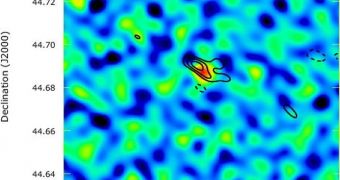In a recent discovery, experts have found a distant stellar explosion that did not behave in the manner expected from such a cosmic event. Namely, the supernova had some of the traits similar to a powerful gamma-ray burst (GRB), but was not exactly either of the two phenomena. Astrophysicists believe that future studies aimed at this type of cross-over explosions may hold the key to better understanding GRBs, which are the most energetic explosions that can occur in the Universe, Space reports.
What was peculiar about the recently found supernova explosion was the fact that it did not emit vast amounts of gamma-rays, as expected from a GRB. Rather, most of its radiation was discovered in lower-energy radio waves. “We think that radio observations will soon be a more powerful tool for finding this kind of supernova in the nearby Universe than gamma-ray satellites,” Alicia Soderberg, an expert at the Cambridge, Massachusetts-based Harvard-Smithsonian Center for Astrophysics (CfA), believes. The team behind this study used the Very Large Array (VLA) radio telescope in New Mexico for their research. The VLA is operated by the US National Science Foundation (NSF).
“Our observations […] provide new clues for the understanding of how supernovae explode, and how some of them may be related to the even more energetic gamma-ray bursts,” scientist Zsolt Paragi explains. He has also been a researcher on this investigation, and he holds an appointment at the Netherlands-based Joint Institute for VLBI (Very Long Baseline Interferometry) in Europe (JIVE). The target of the study was the supernova explosion known as SN2009bb. As a special subset of these cosmic blasts, GRBs are very rare, and can only be observed when looking at the gamma-rays they emit.
However, in the new study, the researchers were not tracking the gamma-ray emissions, but the radio waves the event generated. “Discovering such a supernova by observing its radio emission, rather than through gamma rays, is a breakthrough. With the new capabilities of the Expanded VLA coming soon, we believe we'll find more in the future through radio observations than with gamma-ray satellites,” Soderberg adds. The team hypothesizes that one of the reasons why the gamma-rays themselves were not visible from the Earth is that they were pointing in a different direction.

 14 DAY TRIAL //
14 DAY TRIAL //